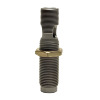Disclaimer: If you have an opinion counter to mine regarding this method, please keep it to yourself. I know I am in the minority of people when it comes to doing things this way with a progressive press. I'm not interested in hearing "that's a waste of time, I do it ...." I'd like to only hear constructive ideas from those that are willing to discuss this two-stage method.
Short Version - If you were to reload on a progressive in two steps, how would you set up your prep stage and your reloading stage. Going to be doing a lot of 9mm and 223/300 blackout. I'd like to be able to lube up my brass, deprime, size, (in the future dillon rt1200) and whatever else I might be suggested to do on a dedicated toolhead. I will then deburr, wash, polish, and store. Reloading stage will be prime, powder/expand, seat, maybe crimp.
Thanks for indulging me. I'm a new dillon xl750 owner, and purchased a case feeder along with it. I have RCBS dies for the most part with a lee deprimer and expander thrown in. My future will include a dillon trimmer, and a bullet feeder.
I'm a self admitted shiny brass snob. I am proud of the way my ammo looks, and it's a personal measure of the quality of my ammo. I have the free time and reloading is a cathartic activity for me. Dedicating a process specific to brass prep is the way I want to go for now. I plan to make this easier for myself by getting a couple armanov toolheads and their lock rings so that I can easily switch between the calibers without tying up too much money/space in toolheads.
I'm planning to run my pistol and rifle brass through a prep stage and store it ready for a final reloading. I've read different setups and methods to do so, and I'm curious to hear what everyone would do or does.
Some of the examples of things not on my radar are using a mandrel, or using alternative dies.
Thanks for the discussion, and for not roasting me over the coals for doing it this way.
Short Version - If you were to reload on a progressive in two steps, how would you set up your prep stage and your reloading stage. Going to be doing a lot of 9mm and 223/300 blackout. I'd like to be able to lube up my brass, deprime, size, (in the future dillon rt1200) and whatever else I might be suggested to do on a dedicated toolhead. I will then deburr, wash, polish, and store. Reloading stage will be prime, powder/expand, seat, maybe crimp.
Thanks for indulging me. I'm a new dillon xl750 owner, and purchased a case feeder along with it. I have RCBS dies for the most part with a lee deprimer and expander thrown in. My future will include a dillon trimmer, and a bullet feeder.
I'm a self admitted shiny brass snob. I am proud of the way my ammo looks, and it's a personal measure of the quality of my ammo. I have the free time and reloading is a cathartic activity for me. Dedicating a process specific to brass prep is the way I want to go for now. I plan to make this easier for myself by getting a couple armanov toolheads and their lock rings so that I can easily switch between the calibers without tying up too much money/space in toolheads.
I'm planning to run my pistol and rifle brass through a prep stage and store it ready for a final reloading. I've read different setups and methods to do so, and I'm curious to hear what everyone would do or does.
Some of the examples of things not on my radar are using a mandrel, or using alternative dies.
Thanks for the discussion, and for not roasting me over the coals for doing it this way.


